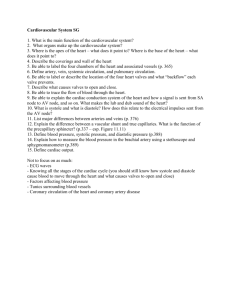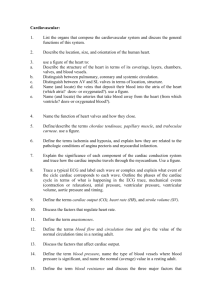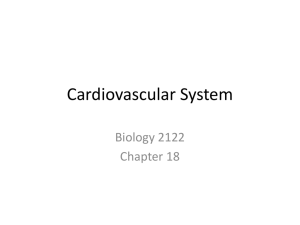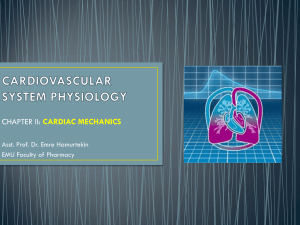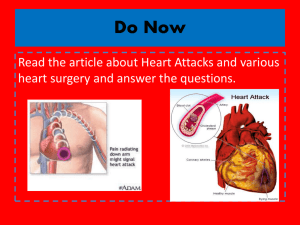The Cardiac Output Curve
advertisement
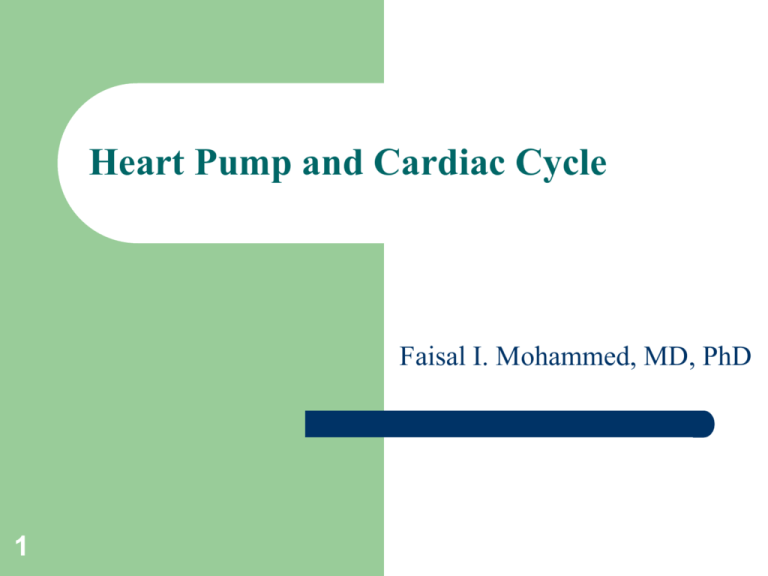
Heart Pump and Cardiac Cycle Faisal I. Mohammed, MD, PhD 1 Objectives 2 To understand the volume, mechanical, pressure and electrical changes during the cardiac cycle To understand the inter-relationship between all these changes To describe the factors that regulate Cardiac output and Stroke volume. Resources: Textbook of Medical Physiology By Guyton and Hall 3 4 Cardiac Cycle Cardiac 5 cycle refers to all events associated with blood flow through the heart – Systole – contraction of heart muscle – Diastole – relaxation of heart muscle Cardiac Cycle 6 Atrial systole 0.1 second Atrial diastole 0.7 second Ventricular systole 0.3 second Isovolumic contraction 0.01 seconds Rapid ejection period Slow ejection period Ventricular diastole 0.5 seconds Isovolumic relaxation 0.02 seconds Rapid filling Slow filling (Diastasis) Atrial contraction Cardiac cycle …cont 7 End diastolic volume (EDV) – End systolic volume (ESV) = Stroke volume (SV) SV X heart rate (HR) = cardiac output (CO) Ejection fraction = SV/EDV Inotropic vs. Chronotropic Autonomic control of cardiac cycle (pump) Phases of the Cardiac Cycle Ventricular filling – mid-to-late diastole – Heart blood pressure is low as blood enters atria and flows into ventricles – AV valves are open, then atrial systole occurs 8 Phases of the Cardiac Cycle Ventricular 9 systole – Atria relax – Rising ventricular pressure results in closing of AV valves – Isovolumetric contraction phase – Ventricular ejection phase opens semilunar valves Phases of the Cardiac Cycle Isovolumetric relaxation – early diastole – Ventricles relax – Backflow of blood in aorta and pulmonary trunk closes semilunar valves Dicrotic notch – brief rise in aortic pressure caused by backflow of blood rebounding off semilunar valves 10 12 Changes during Cardiac cycle 13 Volume changes: End-diastolic volume, End-systolic volume, Stroke volume and Cardiac output. Aortic pressure: Diastolic pressure 80 mmHg, Systolic pressure 120 mmHg, most of systole ventricular pressure higher than aortic Ventricular pressure: Diastolic 0, systolic Lt. 120 Rt. 25 mmHg. Atrial pressure: A wave =atrial systole, C wave= ventricular contraction (AV closure), V wave= ventricular diastole (Av opening) Heart sounds: S1 = turbulence of blood around a closed AV valves, S2 = turbulence of blood around a closed semilunar valves. Heart Sounds 14 Heart Sounds Heart sounds (lub-dup) are associated with closing of heart valves 15 Heart sounds 16 Auscultation – listening to heart sound via stethoscope Four heart sounds – S1 – “lubb” caused by the closing of the AV valves – S2 – “dupp” caused by the closing of the semilunar valves – S3 – a faint sound associated with blood flowing into the ventricles – S4 – another faint sound associated with atrial contraction Cardiac Output (CO) and Reserve 17 CO is the amount of blood pumped by each ventricle in one minute CO is the product of heart rate (HR) and stroke volume (SV) HR is the number of heart beats per minute SV is the amount of blood pumped out by a ventricle with each beat Cardiac reserve is the difference between resting and maximal CO Cardiac Output: Example CO (ml/min) = HR (75 beats/min) x SV (70 ml/beat) CO = 5250 ml/min (5.25 L/min) 18 Regulation of Stroke Volume SV = end diastolic volume (EDV) minus end systolic volume (ESV) EDV = amount of blood collected in a ventricle during diastole ESV = amount of blood remaining in a ventricle after contraction 19 Factors Affecting Stroke Volume – amount ventricles are stretched by contained blood Contractility – cardiac cell contractile force due to factors other than EDV Afterload – back pressure exerted by blood in the large arteries leaving the heart Preload 20 Frank-Starling Law of the Heart Preload, or degree of stretch, of cardiac muscle cells before they contract is the critical factor controlling stroke volume Slow heartbeat and exercise increase venous return to the heart, increasing SV Blood loss and extremely rapid heartbeat decrease SV 21 Preload and Afterload 22 Phases of the Cardiac Cycle 23 Extrinsic Factors Influencing Stroke Volume Contractility is the increase in contractile strength, independent of stretch and EDV Increase in contractility comes from: – Increased sympathetic stimuli – Certain hormones – Ca2+ and some drugs 24 Extrinsic Factors Influencing Stroke Volume 25 Agents/factors that decrease contractility include: – Acidosis – Increased extracellular K+ – Calcium channel blockers Contractility and Norepinephrine Sympathetic stimulation releases norepinephrine and initiates a cyclic AMP secondmessenger system PE 27 Potential Energy (PE) Semilunar Valves Close 120 F Semilunar Valves Open E A-V valves Open LEFT VENTRICULAR PRESSURE (mmHg) LEFT VENTRICULAR PRESSURE/VOLUME P/V LOOP 80 40 D A-V valves Close B C A 0 50 100 150 LEFT VENTRICULAR VOLUME (ml) Valvular Function To prevent back-flow. Chordae tendineae are attached to A-V valves. Papillary muscle, attached to chordae tendineae, contract during systole and help prevent back-flow. Because of smaller opening, velocity through aortic and pulmonary valves exceed that through the A-V valves. 29 Valvular Function (cont’d) Most work is external work or pressure-volume work. A small amount of work is required to impart kinetic energy to the heart (1/2 mV2). What is stroke-volume in previous figure? External work is area of Pressure-Volume curve. Work output is affected by “preload” (end-diastolic pressure) and “afterload” (aortic pressure). Intraventricular Pressure (mmHg) Work Output of the Heart End Systolic Volume 200 150 Period of Ejection Isovolumic Relaxation 100 Isovolumic Contraction 50 End Diastolic Volume 0 50 100 150 200 Period of Filling Left Ventricular Volume (ml) Left Ventricular Pressure A Increased preload 3 2 4 1 Left Ventricular Volume 32 Left Ventricular Pressure B Increased afterload 3 2 4 1 Left Ventricular Volume 33 Left Ventricular Pressure C Increased contractility 3 2 4 1 Left Ventricular Volume 34 PRESSURE/VOLUME RELATIONSHIPS UNDER DIFFERENT CONDITIONS PRELOAD AFTERLOAD CONTRACTILITY 36 Regulation of Heart Rate Positive chronotropic factors increase heart rate Negative chronotropic factors decrease heart rate 37 Regulation of Heart Rate: Autonomic Nervous System 38 Sympathetic nervous system (SNS) stimulation is activated by stress, anxiety, excitement, or exercise Parasympathetic nervous system (PNS) stimulation is mediated by acetylcholine and opposes the SNS PNS dominates the autonomic stimulation, slowing heart rate and causing vagal tone Atrial (Bainbridge) Reflex (Bainbridge) reflex – a sympathetic reflex initiated by increased blood in the atria – Causes stimulation of the SA node – Stimulates baroreceptors in the atria, causing increased SNS stimulation Atrial 39 Chemical Regulation of the Heart The hormones epinephrine and thyroxine increase heart rate Intra- and extracellular ion concentrations must be maintained for normal heart function 40 Important Concepts About Cardiac Output (CO) Control • Cardiac Output is the sum of all tissue flows and is affected by their regulation (CO = 5L/min, cardiac index = 3L/min/m2 (surface area in m2). • CO is proportional to tissue O2. use. • CO is proportional to 1/TPR when AP is constant. • CO = (MAP - RAP) / TPR 41 25 HYPEREFFECTIVE CARDIAC OUTPUT (L/min) CARDIAC OUTPUT CURVES 20 15 NORMAL 10 5 HYPOEFFECTIVE 0 -4 0 +4 +8 RIGHT ATRIAL PRESSURE (mmHg) The Cardiac Output Curve • Plateau of CO curve determined by heart strength (contractility + HR) • Sympathetics plateau • Parasympathetics (HR) plateau) • Plateau • Heart hypertrophy ’s plateau • Myocardial infarction plateau) • Plateau The Cardiac Output Curve (cont’d) • Valvular disease plateau (stenosis or regurgitation) • Myocarditis plateau • Cardiac tamponade plateau) • Plateau • Metabolic damage plateau Ventricular Pressure and Volume Curves (cont’d) 45 During the latter part of the ejection phase how can blood still leave the ventricle if pressure is higher in the aorta? Momentum of blood flow Total energy of blood = P + mV2/2 = pressure + kinetic energy Total energy of blood leaving ventricle is greater than in aorta. Ejection Fraction 46 End diastolic volume = 125 ml End systolic volume = 55 ml Ejection volume (stroke volume) = 70 ml Ejection fraction = 70ml/125ml = 56% (normally 60%) If heart rate (HR) is 70 beats/minute, what is cardiac output? Cardiac output = HR * stroke volume = 70/min. * 70 ml = 4900ml/min. Ejection Fraction (cont’d) 47 If HR =100, end diastolic volume = 180 ml, end systolic vol. = 20 ml, what is cardiac output? C.O. = 100/min. * 160 ml = 16,000 ml/min. Ejection fraction= 160/180%=~ 90% Aortic Pressure Curve Aortic pressure starts increasing during systole after the aortic valve opens. Aortic pressure decreases toward the end of the ejection phase. After the aortic valve closes, an incisura occurs because of sudden cessation of back-flow toward left ventricle. Aortic pressure decreases slowly during diastole because of the elasticity of the aorta. 48 Frank-Starling Mechanism Within physiological limits the heart pumps all the blood that comes to it without excessive damming in the veins. Extra stretch on cardiac myocytes makes actin and myosin filaments interdigitate to a more optimal degree for force generation. Ventricular Stroke Work Output 40 30 L.V. stroke work (gram meters) 4 3 20 2 10 1 0 0 10 20 Left Atrial Mean Pressure (mm Hg) R.V. stroke work (gram meters) 10 20 Right Atrial Mean Pressure (mm Hg) Autonomic Effects on Heart Sympathetic stimulation causes increased HR and increased contractility with HR = 180-200 and C.O. = 15-20 L/min. Parasympathetic stimulation decreases HR markedly and decreases cardiac contractility slightly. Vagal fibers go mainly to atria. Fast heart rate (tachycardia) can decrease C.O. because there is not enough time for heart to fill during diastole. Effect of Sympathetic and Parasympathetic Stimulation on Cardiac Output Maximum sympathetic stimulation Cardiac Output (L/min) 25 20 Normal sympathetic stimulation 15 Zero sympathetic stimulation 10 (Parasympathetic stimulation) 5 0 -4 0 +4 +8 Right Atrial Pressure (mmHg) Cardiac Contractility Best is to measure the C.O. curve, but this is nearly impossible in humans. dP/dt is not an accurate measure because this increases with increasing preload and afterload. (dP/dt)/P ventricle is better. P ventricle is instantaneous ventricular pressure. Excess K+ decreases contractility. Excess Ca++ causes spastic contraction, and low Ca++ causes cardiac dilation. Thank You 54

